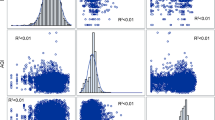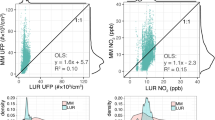Abstract
Epidemiologic studies commonly use residential locations to estimate environmental exposures or community-level characteristics. The impact of residential mobility on these characteristics, however, is rarely considered. The objective of this analysis was to examine the effect of residential mobility on estimates of traffic-related air pollution (TRAP), greenspace, and community-level characteristics. All residential addresses were reported from birth through age seven for children enrolled in the Cincinnati Childhood Allergy and Air Pollution Study. Exposure to TRAP at each address was estimated using a land use model. Greenspace was estimated using satellite imagery. Indices of neighborhood deprivation and race were created based on socioeconomic-census tract measures. Exposure estimates using the birth record address, the last known address, and the annual address history were used to determine exposure estimation error and bias in the association with asthma at age seven. Overall, 54% of the cohort moved at least once prior to age seven. Each move was separated by a median of 4 miles and associated with a median decrease of 4.4% in TRAP exposure, a 5.3% increase in greenspace, an improved deprivation index, and no change in the race index. Using the birth record address or the last known address instead of the annual address history resulted in exposure misclassification leading to a bias toward the null when associating the exposures with asthma. Using a single address to estimate environmental exposures and community-level characteristics over a time period may result in differential assessment error.
This is a preview of subscription content, access via your institution
Access options
Subscribe to this journal
Receive 6 print issues and online access
$259.00 per year
only $43.17 per issue
Buy this article
- Purchase on Springer Link
- Instant access to full article PDF
Prices may be subject to local taxes which are calculated during checkout




Similar content being viewed by others
References
Aguilera I, Sunyer J, Fernández-Patier R, Hoek G, Aguirre-Alfaro A, Meliefste K et al. Estimation of outdoor NOx, NO2, and BTEX exposure in a cohort of pregnant women using land use regression modeling. Environ Sci Technol 2007; 42: 815–821.
Beelen R, Hoek G, Vienneau D, Eeftens M, Dimakopoulou K, Pedeli X et al. Development of NO 2 and NO x land use regression models for estimating air pollution exposure in 36 study areas in Europe–the ESCAPE project. Atmos Environ 2013; 72: 10–23.
Mukerjee S, Smith LA, Johnson MM, Neas LM, Stallings CA . Spatial analysis and land use regression of VOCs and NO 2 from school-based urban air monitoring in Detroit/Dearborn, USA. Sci Total Environ 2009; 407: 4642–4651.
Hystad P, Davies HW, Frank L, Van Loon J, Gehring U, Tamburic L et al. Residential greenness and birth outcomes: evaluating the influence of spatially correlated built-environment factors. Environ Health Perspect 2014; 122: 1095–1102.
Eeftens M, Beelen R, de Hoogh K, Bellander T, Cesaroni G, Cirach M et al. Development of land use regression models for PM2. 5, PM2. 5 absorbance, PM10 and PMcoarse in 20 European study areas; results of the ESCAPE project. Environ Sci Technol 2012; 46: 11195–11205.
de Hoogh K, Wang M, Adam M, Badaloni C, Beelen R, Birk M et al. Development of land use regression models for particle composition in twenty study areas in Europe. Environ Sci Technol 2013; 47: 5778–5786.
Signorello LB, Cohen SS, Williams DR, Munro HM, Hargreaves MK, Blot WJ . Socioeconomic status, race, and mortality: a prospective cohort study. Am J Public Health 2014; 104: e98–e107.
Van Ryswyk K, Wheeler AJ, Wallace L, Kearney J, You H, Kulka R et al. Impact of microenvironments and personal activities on personal PM2. 5 exposures among asthmatic children. J Expo Sci Environ Epidemiol 2014; 24: 260–268.
Brokamp C, Rao M, Fan ZT, Ryan PH . Does the elemental composition of indoor and outdoor PM2. 5 accurately represent the elemental composition of personal PM2. 5? Atmos Environ 2015; 101: 226–234.
Gehring U, Wijga AH, Brauer M, Fischer P, de Jongste JC, Kerkhof M et al. Traffic-related air pollution and the development of asthma and allergies during the first 8 years of life. Am J Respir Crit Care Med 2010; 181: 596–603.
Brauer M, Hoek G, Smit H, De Jongste J, Gerritsen J, Postma DS et al. Air pollution and development of asthma, allergy and infections in a birth cohort. Eur Respir J 2007; 29: 879–888.
Gan WQ, Tamburic L, Davies HW, Demers PA, Koehoorn M, Brauer M . Changes in residential proximity to road traffic and the risk of death from coronary heart disease. Epidemiology 2010; 21: 642–649.
Andersen ZJ, Raaschou-Nielsen O, Ketzel M, Jensen SS, Hvidberg M, Loft S et al. Diabetes incidence and long-term exposure to air pollution a cohort study. Diabetes Care 2012; 35: 92–98.
Oudin A, Forsberg B, Strömgren M, Beelen R, Modig L . Impact of residential mobility on exposure assessment in longitudinal air pollution studies: a sensitivity analysis within the ESCAPE project. Sci World J 2012; 2012: 125818.
Canfield MA, Ramadhani TA, Langlois PH, Waller DK . Residential mobility patterns and exposure misclassification in epidemiologic studies of birth defects. J Expo Sci Environ Epidemiol 2006; 16: 538–543.
Chen L, Bell EM, Caton AR, Druschel CM, Lin S . Residential mobility during pregnancy and the potential for ambient air pollution exposure misclassification. Environ Res 2010; 110: 162–168.
Heckel PF, LeMasters GK . The use of AERMOD air pollution dispersion models to estimate residential ambient concentrations of elemental mercury. Water Air Soil Pollut 2011; 219: 377–388.
Ackerman BP, Kogos J, Youngstrom E, Schoff K, Izard C . Family instability and the problem behaviors of children from economically disadvantaged families. Dev Psychol 1999; 35: 258–268.
Long L . Changing residence: comparative perspectives on its relationship to age, sex, and marital status. Population Studies 1992; 46: 141–158.
Böheim R, Taylor MP . Tied down or room to move? Investigating the relationships between housing tenure, employment status and residential mobility in Britain. Scot J Polit Econ 2002; 49: 369–392.
Astone NM, McLanahan SS . Family structure, residential mobility, and school dropout: a research note. Demography 1994; 31: 575–584.
Jelleyman T, Spencer N . Residential mobility in childhood and health outcomes: a systematic review. J Epidemiol Community Health 2008; 62: 584–592.
LeMasters GK, Wilson K, Levin L, Biagini J, Ryan P, Lockey JE et al. High prevalence of aeroallergen sensitization among infants of atopic parents. J Pediatr 2006; 149: 505–511.
Ryan PH, LeMasters G, Biagini J, Bernstein D, Grinshpun SA, Shukla R et al. Is it traffic type, volume, or distance? Wheezing in infants living near truck and bus traffic. J Allergy Clin Immunol 2005; 116: 279–284.
Brunst KJ, Ryan PH, Brokamp C, Bernstein D, Reponen T, Lockey J et al. Timing and duration of traffic-related air pollution exposure and the risk for childhood wheeze and asthma. Am J Respir Crit Care Med 2015; 192: 421–427.
Ryan PH, Lemasters GK, Biswas P, Levin L, Hu S, Lindsey M et al. A comparison of proximity and land use regression traffic exposure models and wheezing in infants. Environ Health Perspect 2007; 115: 278–284.
Hijmans R, van Etten J . raster: raster: geographic data analysis and modeling. R package version. 2014;517:2.-12.
Bivand R, Rundel C . rgeos: interface to geometry engine-open source (GEOS). R package version 02-13. 2013.
Keitt TH, Bivand R, Pebesma E, Rowlingson B . rgdal: bindings for the Geospatial Data Abstraction Library. R package version 07-1, URL http://CRANR-projectorg/package=rgdal2011.
Karner AA, Eisinger DS, Niemeier DA . Near-roadway air quality: synthesizing the findings from real-world data. Environ Sci Technol 2010; 44: 5334–5344.
Ryan PH, Son SY, Wolfe C, Lockey J, Brokamp C, LeMasters G . A field application of a personal sensor for ultrafine particle exposure in children. Sci Total Environ 2015; 508: 366–373.
Maas J, Verheij RA, Groenewegen PP, De Vries S, Spreeuwenberg P . Green space, urbanity, and health: how strong is the relation? J Epidemiol Commun Health 2006; 60: 587–592.
Flouri E, Midouhas E, Joshi H . The role of urban neighbourhood green space in children's emotional and behavioural resilience. J Environ Psychol 2014; 40: 179–186.
Astell-Burt T, Mitchell R, Hartig T . The association between green space and mental health varies across the lifecourse. A longitudinal study. J Epidemiol Commun Health 2014; 68: 578–583.
Acknowledgements
The authors thank the study and clinic staff for their efforts in study coordination, subject recruitment, data management, and data collection. They also thank the participating CCAAPS families for their time and effort. This work was supported by grants from the National Institute of Environmental Health Sciences (5R01ES011170 and R01ES019890).
Author information
Authors and Affiliations
Corresponding author
Ethics declarations
Competing interests
The authors declare no conflict of interest.
Additional information
Supplementary Information accompanies the paper on the Journal of Exposure Science and Environmental Epidemiology website
Supplementary information
Rights and permissions
About this article
Cite this article
Brokamp, C., LeMasters, G. & Ryan, P. Residential mobility impacts exposure assessment and community socioeconomic characteristics in longitudinal epidemiology studies. J Expo Sci Environ Epidemiol 26, 428–434 (2016). https://doi.org/10.1038/jes.2016.10
Received:
Accepted:
Published:
Issue Date:
DOI: https://doi.org/10.1038/jes.2016.10
Keywords
This article is cited by
-
Increased urban greenspace in childhood associated with lower inattention deficit among adolescents
Social Psychiatry and Psychiatric Epidemiology (2024)
-
Pediatric outdoor recreational injuries: another hidden concern during the COVID-19 pandemic
Injury Epidemiology (2023)
-
Impact of standardization on racial and socioeconomic disparities in non-accidental trauma evaluations in infants in a pediatric emergency department
Injury Epidemiology (2023)
-
Predictors of early life residential mobility in urban and rural Pennsylvania children with acute lymphoblastic leukemia and implications for environmental exposure assessment
Journal of Exposure Science & Environmental Epidemiology (2023)
-
Impact of Environmental Exposures on Lung Cancer in Patients Who Never Smoked
World Journal of Surgery (2023)



